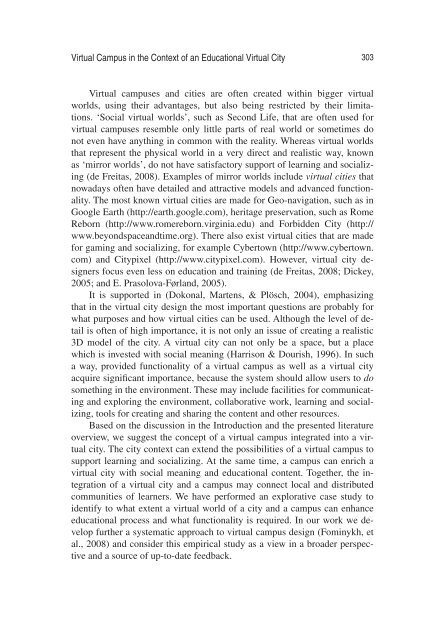Disputation Mikhail Fominykh - Department of Computer and ...
Disputation Mikhail Fominykh - Department of Computer and ...
Disputation Mikhail Fominykh - Department of Computer and ...
You also want an ePaper? Increase the reach of your titles
YUMPU automatically turns print PDFs into web optimized ePapers that Google loves.
Virtual Campus in the Context <strong>of</strong> an Educational Virtual City 303<br />
Virtual campuses <strong>and</strong> cities are <strong>of</strong>ten created within bigger virtual<br />
worlds, using their advantages, but also being restricted by their limitations.<br />
‘Social virtual worlds’, such as Second Life, that are <strong>of</strong>ten used for<br />
virtual campuses resemble only little parts <strong>of</strong> real world or sometimes do<br />
not even have anything in common with the reality. Whereas virtual worlds<br />
that represent the physical world in a very direct <strong>and</strong> realistic way, known<br />
as ‘mirror worlds’, do not have satisfactory support <strong>of</strong> learning <strong>and</strong> socializing<br />
(de Freitas, 2008). Examples <strong>of</strong> mirror worlds include virtual cities that<br />
nowadays <strong>of</strong>ten have detailed <strong>and</strong> attractive models <strong>and</strong> advanced functionality.<br />
The most known virtual cities are made for Geo-navigation, such as in<br />
Google Earth (http://earth.google.com), heritage preservation, such as Rome<br />
Reborn (http://www.romereborn.virginia.edu) <strong>and</strong> Forbidden City (http://<br />
www.beyondspace<strong>and</strong>time.org). There also exist virtual cities that are made<br />
for gaming <strong>and</strong> socializing, for example Cybertown (http://www.cybertown.<br />
com) <strong>and</strong> Citypixel (http://www.citypixel.com). However, virtual city designers<br />
focus even less on education <strong>and</strong> training (de Freitas, 2008; Dickey,<br />
2005; <strong>and</strong> E. Prasolova-Førl<strong>and</strong>, 2005).<br />
It is supported in (Dokonal, Martens, & Plösch, 2004), emphasizing<br />
that in the virtual city design the most important questions are probably for<br />
what purposes <strong>and</strong> how virtual cities can be used. Although the level <strong>of</strong> detail<br />
is <strong>of</strong>ten <strong>of</strong> high importance, it is not only an issue <strong>of</strong> creating a realistic<br />
3D model <strong>of</strong> the city. A virtual city can not only be a space, but a place<br />
which is invested with social meaning (Harrison & Dourish, 1996). In such<br />
a way, provided functionality <strong>of</strong> a virtual campus as well as a virtual city<br />
acquire significant importance, because the system should allow users to do<br />
something in the environment. These may include facilities for communicating<br />
<strong>and</strong> exploring the environment, collaborative work, learning <strong>and</strong> socializing,<br />
tools for creating <strong>and</strong> sharing the content <strong>and</strong> other resources.<br />
Based on the discussion in the Introduction <strong>and</strong> the presented literature<br />
overview, we suggest the concept <strong>of</strong> a virtual campus integrated into a virtual<br />
city. The city context can extend the possibilities <strong>of</strong> a virtual campus to<br />
support learning <strong>and</strong> socializing. At the same time, a campus can enrich a<br />
virtual city with social meaning <strong>and</strong> educational content. Together, the integration<br />
<strong>of</strong> a virtual city <strong>and</strong> a campus may connect local <strong>and</strong> distributed<br />
communities <strong>of</strong> learners. We have performed an explorative case study to<br />
identify to what extent a virtual world <strong>of</strong> a city <strong>and</strong> a campus can enhance<br />
educational process <strong>and</strong> what functionality is required. In our work we develop<br />
further a systematic approach to virtual campus design (<strong>Fominykh</strong>, et<br />
al., 2008) <strong>and</strong> consider this empirical study as a view in a broader perspective<br />
<strong>and</strong> a source <strong>of</strong> up-to-date feedback.
















